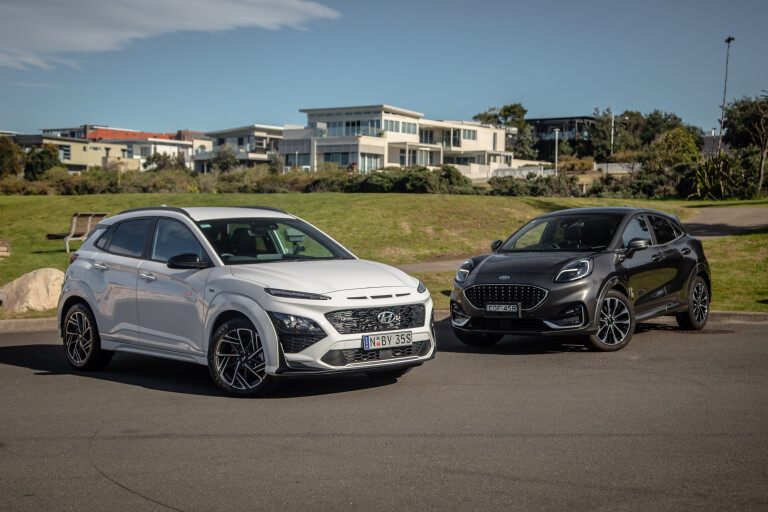
About $40,000 drive-away or less. Crossover body style. Sporty aesthetics. Turbocharged performance.
The Hyundai Kona N-Line and Ford Puma ST-Line V are two models that tick all four of the above tempting boxes.
Ford’s hatchback/SUV is the newer vehicle, introduced in September 2020 as a replacement for the unloved EcoSport. It’s also Ford Australia’s entry model after the company stopped importing the Fiesta city car (except for the ST hot hatch version).
The Puma’s underpinnings are based on the Fiesta’s, where the Kona is related to the i30 small car, yet the two models are virtually identical in size at 4.2-something metres.
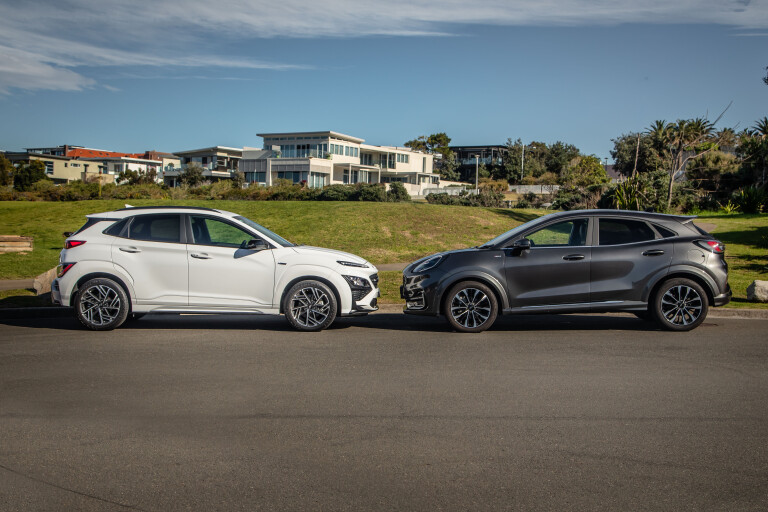
The specific variants in this comparison also share badges inspired by performance ranges.
Hyundai’s Kona N-Line, a new variant introduced in 2021 as part of a mid-life model update, ties in with the Korean brand’s N performance models, which started with the i30 N and later this year will include a Kona N.
The Puma ST-Line trades off the ST badge applied to fast Fords, which includes the Fiesta ST and Focus ST hot-hatches sold here. And there’s also a Puma ST available overseas that would make a natural rival for the Kona N, though Ford Australia has so far opted against bringing it here.
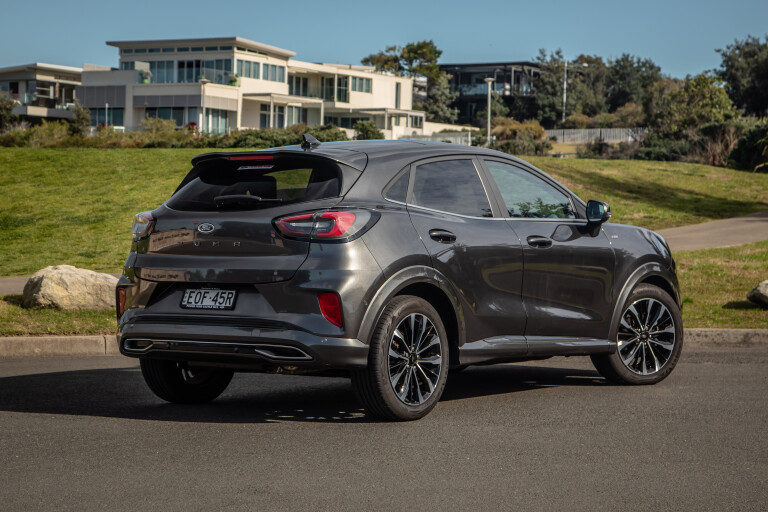
Built in Romania whereas its predecessor was made in India, the three-grade Puma range begins at $29,990 and ends at $35,540 before on-road charges (or about $39,500 drive-away) for the ST-Line V we have here.
Hyundai’s seven-tier Kona line-up starts from $26,600 before on-roads, with its N-Line variant squaring up neatly to the top Puma with a $36,300 RRP (and about $40,200 drive-away).
The Kona N-Line and Puma ST-Line both make visual nods to their respective N and ST performance siblings, each wearing bodykits with more aggressive-looking bumpers and extended side skirts, as well as multi-spoked 18-inch alloy wheels.

For $500, the Puma can be had with a contrasting black roof. To get the same (no-cost) option on the Kona N-Line, buyers must step up to the $42,400 N-Line Premium.
Hyundai charges $595 for premium paints, with three colours carrying no extra charge. Ford asks $650 for all colours except white.
LED daytime running lights are standard on both models but only the Puma features LED headlights. These are again found only on the N-Line Premium.
Ford’s keyless entry set-up is also slightly more advanced, allowing the closure of windows and sunroof with a hold of the lock button on the key fob. The Kona also needs a button to be pressed on the door handle to open the door.
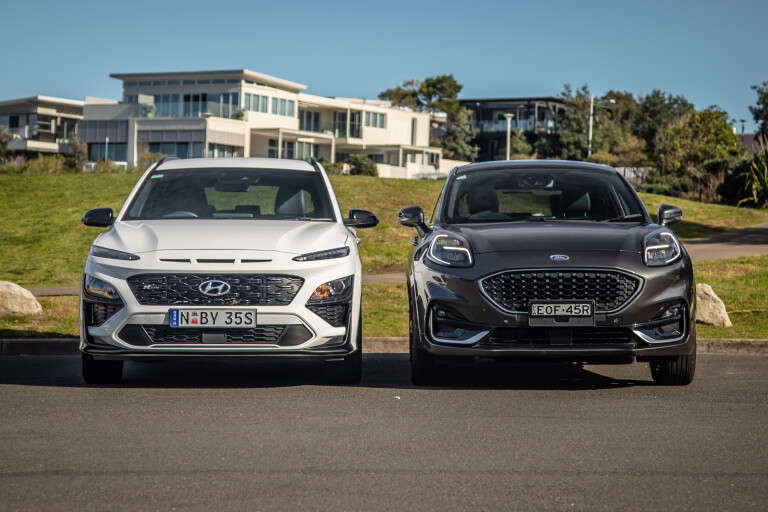
A multitude of sporty embellishments are applied to the cabins.
This includes a liberal amount of stitching in various areas, including seats and steering wheels. The stitches are red in the Kona N-Line and white in the ST-Line V (yet red in the mid-range ST-Line).
The Kona adds anodised-red touches for the gear lever and side dash vents. The Puma’s dash plastics include an infotainment and instrument cluster surround that mimics carbonfibre weave.
The Kona N-Line and Puma ST-Line both make visual nods to their respective N and ST performance siblings, each wearing bodykits as well as 18-inch wheels.
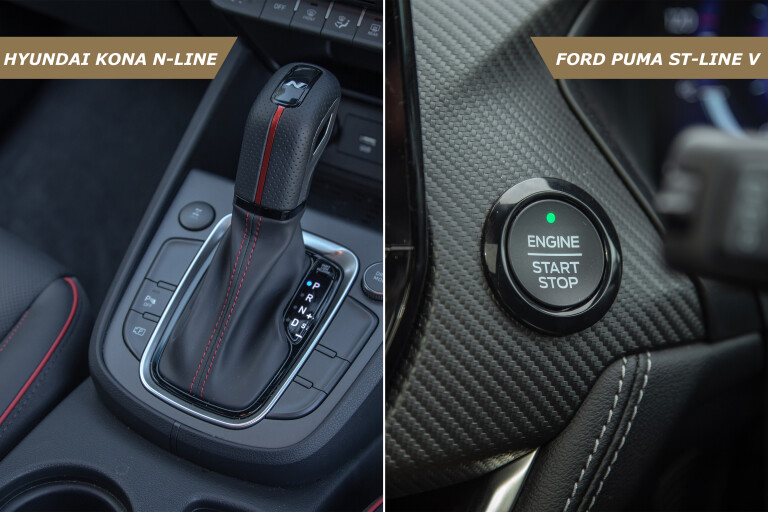
The Puma also spruces up its door trim with white-stitched leatherette panels, which overall give the Ford a slightly higher percentage of soft materials, though hard plastics are common to both interiors.
Headlining quality is higher in the Puma, which also features blue LED ambient lighting, plus an auto-dimming rear-view mirror.
While the Kona’s N-badged front seats look the sportiest here, the Puma’s are plenty supportive and upholstered in full leather where the Hyundai’s are leather-accented only.
Its manual seat adjustment all round; electric operation plus heating/cooling features on the N-Line Premium.
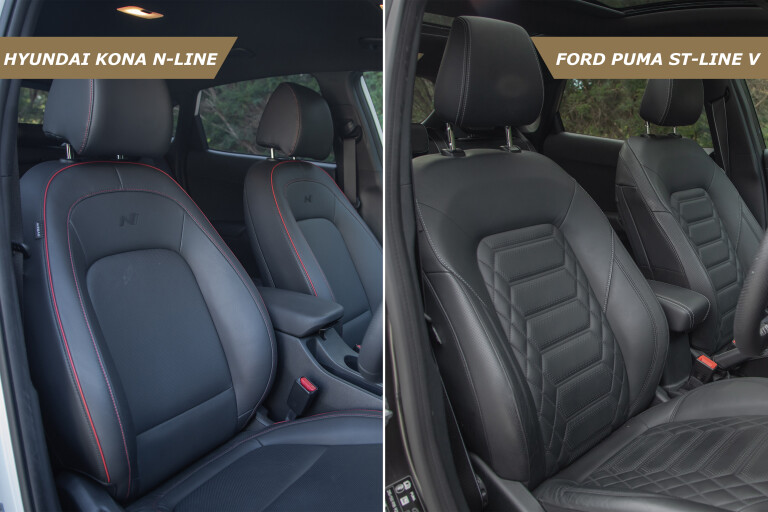
The Kona N-Line is equipped with Hyundai’s latest infotainment touchscreen – a 10.25-inch display that is smartly presented and easy to use.
Ford’s 8.0-inch display may give away 20 per cent in touchscreen real estate but it doesn’t look undersized for the cabin and its interface is brightly and sharply presented, and highly intuitive.
Each infotainment system comes with an ear-pleasing branded audio system – Harman Kardon for the Kona, B&O (Bang & Olufsen) Play for the Puma – as well as digital radio and Apple CarPlay/Android Auto smartphone interfaces. Wireless smartphone charging trays with USB ports are also shared.
The Ford has the more sophisticated-looking instrument cluster – a 12-inch-diameter digital screen that matches the colouring and clarity of the infotainment screen. Steering wheel buttons allow the driver to flick through pages of info/functions, though there’s no option for customisable layouts as with fully digital driver displays offered by the likes of the VW T-Cross and Skoda Kamiq.

Hyundai matches that only with the more expensive N-Line Premium. The regular N-Line has a digital info panel sandwiched between conventional dials.
The Puma’s display includes a helpful speed limit notification that’s enabled by a forward camera, where the Kona’s is GPS-based and only available on the centre screen when the nav-map is being used.
Neither the Kona nor Puma offer generous rear-seat legroom, though there’s more in the Ford if average-height adults are seated front and rear. The Puma skips a centre armrest and both models lack rear vents.
Our Puma test car was also fitted with the optional ($2000) electric panoramic sunroof, which brings extra light (and fresh air if you want) into the cabin.
Back-seat space is less of an issue if child seats are being used, though the Puma makes for the better small-family vehicle with its superior boot.
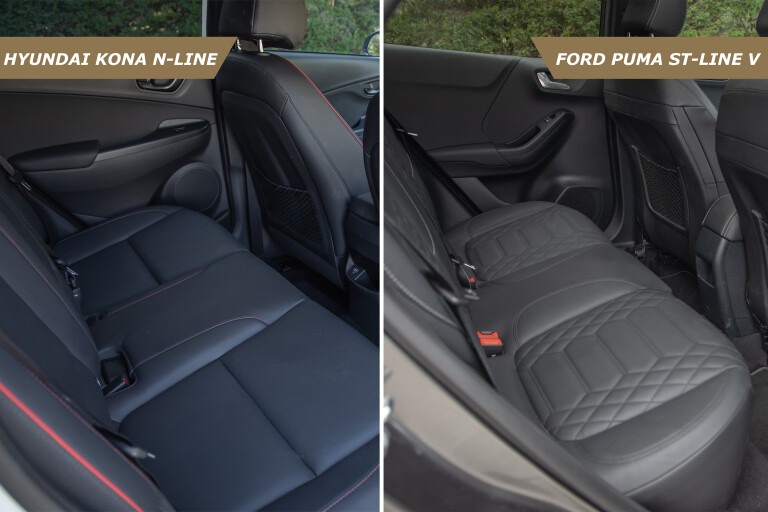
The Kona’s luggage compartment is relatively shallow and limited in length – even making it smaller and less practical than the i30 hatch’s boot.
The Puma’s 410-litre boot volume trumps its rival’s 374 litres beyond on-paper figures. It offers greater versatility with adjustable floor levels, with the highest allowing for a flat load bay when the rear seats are folded down. The Ford also includes a handy storage tub under the floor, with access made more convenient by the ability to click the floor into an upward position.
It’s easier to fit suitcases, prams, or kids’ scooters in the Puma’s boot, which provides the extra advantage of an automatic tailgate in this ST-Line V spec.
Both vehicles include a temporary spare wheel under the boot floor, as well as tyre pressure monitoring and 24-hour roadside assistance (refreshed with each official service).

There are significant mechanical variations between the N-Line and ST-Line.
The Hyundai has multi-link rear suspension, while the Puma goes with a theoretically inferior semi-independent torsion-beam set-up (as with regular versions of the Kona).
And while both models feature turbocharged engines, the Kona has a 1.6-litre four-cylinder compared with a 1.0-litre three-cylinder for the Puma. The Kona can also send power to all four wheels via an on-demand AWD system where the Puma is front-drive only, though both use seven-speed dual-clutch automatic transmissions.
The Kona sends power to all four wheels via an on-demand AWD system whereas the Puma is front-drive only.
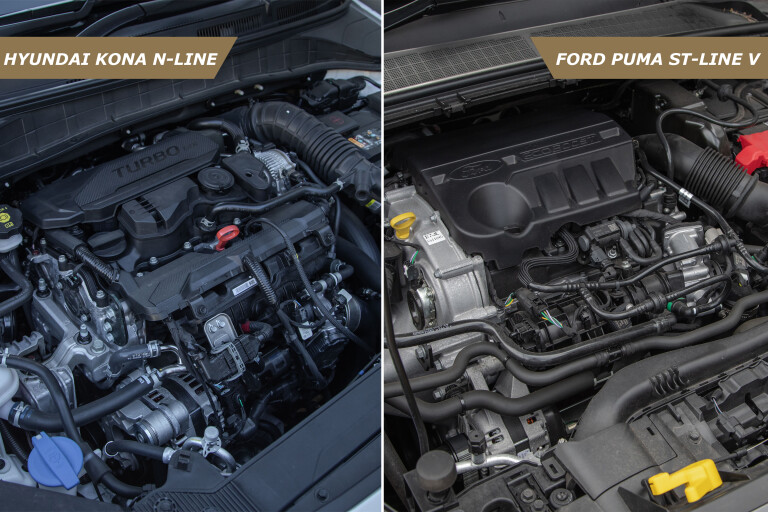
A bigger engine ensures the Kona N-Line outguns its Ford rival – producing 146kW and 265Nm for ‘warm-hatch’ levels of performance.
The Puma ST-Line V uses the same drivetrain as every variant, with frankly modest outputs of 92kW and 170Nm.
Yet this is less of an all-round performance-advantage slam-dunk for the Hyundai and more of a ball-circling-the-rim-before-dropping-through scenario.
The Hyundai undoubtedly offers stronger in-gear acceleration, and its all-wheel-drive system gets it off the line quicker (though neither manufacturer provides 0-100km/h sprint claims).
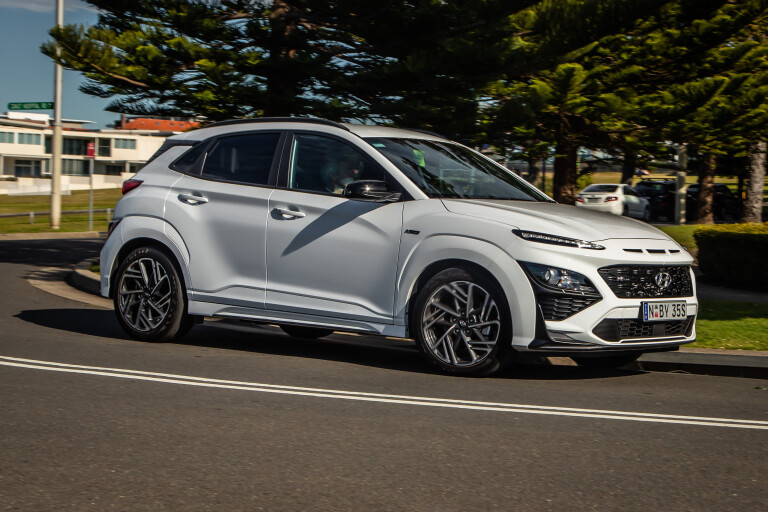
In everyday driving, however, the Puma feels more responsive at the throttle pedal without feeling overly reactive. The fizzy three-cylinder feels particularly alert at low to medium speeds, helped by an auto that is quick to shift down a gear if needed. There’s audible character in the form of the engine’s trademark warble.
In contrast, the Hyundai’s auto seems to have been calibrated with a fuel-economy bias, and its determination to keep revs below 1500pm makes the Kona N-Line lack the Puma’s relatively effortless feel.
There is a simple fix: rotate the Drive Modes dial on the centre console to move from the default Comfort to Sport. This brings much livelier progress, though the tendency to hang onto gears longer means Sport mode may become tiring if used for too long around town.

A Sport mode is also available in the Puma, though it’s arguably redundant for all but the twistiest of country roads such is the sufficient enthusiasm of its Normal setting.
And when you do encounter such roads, the Ford is in a league of its own for driver enjoyment. This applies beyond this comparison to the entire segment.
The Puma’s chubbier, perforated steering wheel not only feels more tactile in the hands but delivers a stronger sense of connection to the vehicle’s front end.
The Puma has a playful nature that showcases the DNA it shares with the Fiesta ST. The Hyundai offers driver confidence with its grippy tyres and tied-down chassis.

Turning in to corners more keenly than the Kona N-Line and feeling even more poised with directional changes, the Puma has a wonderfully playful nature that showcases some of the DNA it shares with the Fiesta ST.
It imparts this feeling irrespective of speed, so the Puma is rewarding to drive even when navigating suburban streets and roundabouts.
The Puma, with a kerb weight of 1291kg, is also notably lighter than the N-Line that’s closer to 1500kg.
That’s not to suggest the Kona N-Line is dull by any means. A dynamic link to the i30 N hot-hatch may be more tenuous than that of the Puma-Fiesta ST relationship, but the Hyundai offers its driver copious amounts of confidence with its grippy tyres, tied-down chassis, and nicely modulated brakes.
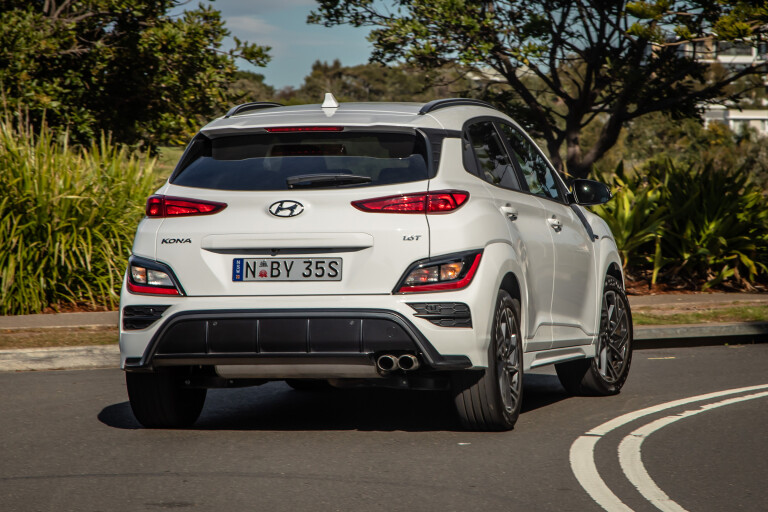
To best enjoy the Kona, however, its Lane Keep Assist system must be switched off (done by holding the steering wheel icon on, well, the steering wheel for a couple of seconds).
The system, at 60km/h and above, can otherwise act like a phantom driver, making small tugs at the steering wheel in the frequently erroneous belief that the Kona is crossing lane markings.
It’s a default setting, unfortunately. The Puma has a similar system, yet you wouldn’t know it existed unless the vehicle is actually encroaching on lane markings without indicating.

The Ford’s driver-assistance technology isn’t complete without a $1500 Park Pack, however. Only with this can the Puma match the Kona N-Line’s standard adaptive cruise control, blind-spot monitoring and rear cross-traffic alert.
It also gives the Puma front parking sensors and a semi-auto parking system as advantages, while auto high-beam is standard. Front sensors and anti-dazzling headlights are available only on the Premium version of the Kona N-Line.
Both crossover vehicles have a firmish ride, the tuning of springs and dampers aligned with their respective performance-inspired N-Line and ST-Line badges.
Crucially, both models provide adequate comfort to ensure they’re not tiresome for daily driving. The Kona has the slightly more supple suspension, while the Puma is slightly better at absorbing bigger bumps.
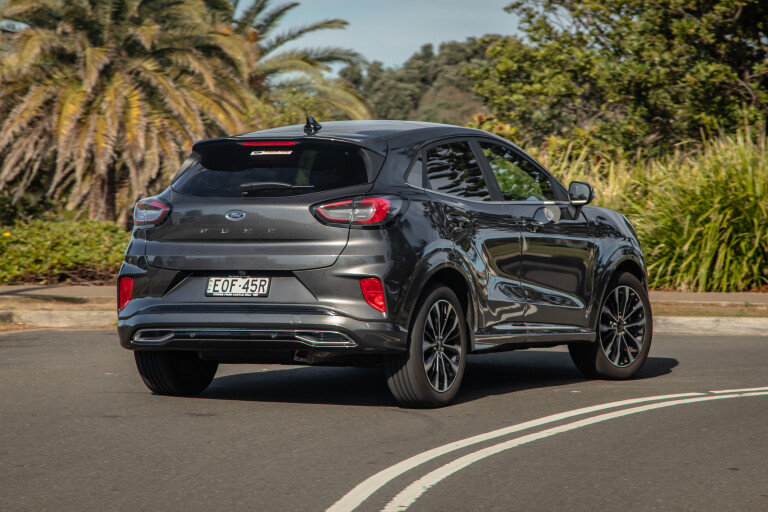
Running costs will depend on your typical annual mileage and fuel-grade preference.
The Kona N-Line’s engine can run on regular unleaded to help keep costs down, where the Puma requires 95 premium unleaded as a minimum. Our testing suggests there should be some offset for the Ford, which averaged a bit over a litre less than the Hyundai every 100km.
Just don’t expect to match quoted fuel consumption figures of 5.3L/100km for the Puma or 6.9L/100km for the Kona, unless you’re doing a significant amount of freeway driving.
Servicing costs are similar over three years (Kona $957; Puma $1010) and not wildly different over five years (Kona $1595; Puma $1895). However, the Hyundai’s mileage intervals are short at 10,000km, where the Puma’s intervals are the 15,000km industry average.
Ford and Hyundai provide five-year factory warranties.
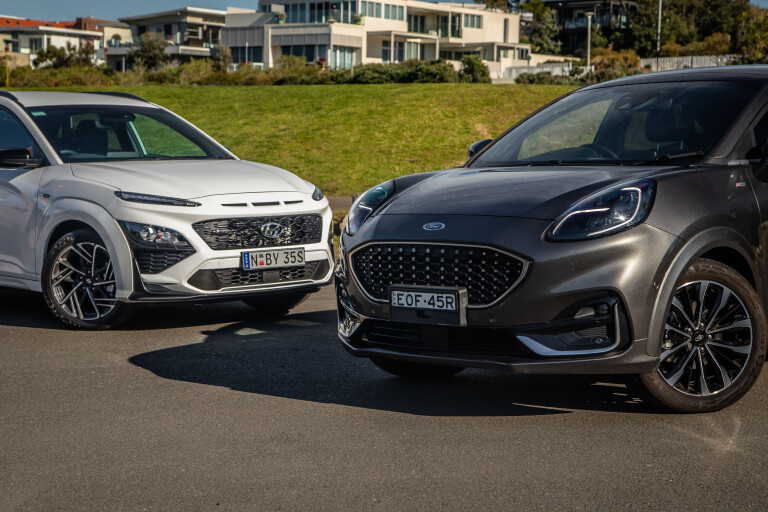
It wouldn’t be unfair to remark that the $40,000-odd required to drive away in a Ford Puma ST-Line V and Hyundai Kona N-Line is quite steep for a compact crossover.
For less money than this Puma, you could have the brilliant Fiesta ST hot hatch that comes with a more powerful engine. In the case of the Kona, you could have an i30 N-Line hatch for several grand less, or, for similar money, an i30 N-Line Premium that comes with significantly more features.
This pricing quirk is common to the compact SUV segment in which the Puma and Kona reside.
For less money than this Puma, you could have the Fiesta ST that comes with a more powerful engine. In the case of the Kona, an i30 N-Line hatch for several grand less.
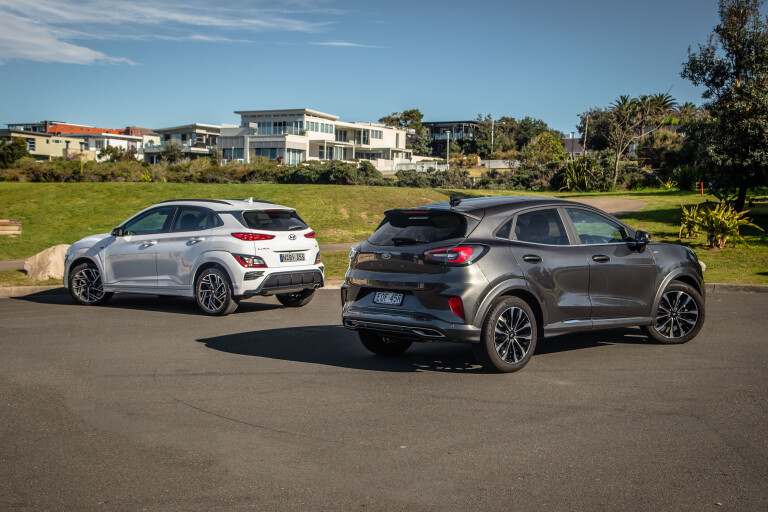
A key distinction for the Puma, however, is that it’s bigger and more practical than the Fiesta on which it’s based, while the Kona is smaller than the i30 hatch and has a less practical boot.
The Puma also bests the Kona for interior and luggage space, while also offering many features that are either missing from the Hyundai or can only be matched by opting for the more expensive N-Line Premium.
The Kona N-Line does have the advantage of all-wheel drive, though we’d suggest it’s a debatable one for the typical compact SUV owner. The Puma does include Trail/Slippery driving modes to help its front wheels deal with, respectively, looser and wetter surfaces.
Also take into account that the Puma ST-Line V puts more of the ‘ST’ into the way it drives than the Kona N-Line puts the ‘N’ into its motoring, and overall there’s a clear winner here.
2021 Hyundai Kona N-Line vs Ford Puma ST-Line V specifications
| Hyundai Kona N-Line | Ford Puma ST-Line V | |
| Body | 5-door crossover | |
| Drive | On-demand AWD | FWD |
| Engine | 1.6-litre turbo 4-cylinder | 1.0-litre turbo 3-cylinder |
| Transmission | 7-speed dual-clutch auto | |
| Power | 146kW @ 6000rpm | 92kW @ 6000rpm |
| Torque | 265Nm @ 1600-4500rpm | 170Nm @ 1500-4500rpm |
| Bore/Stroke | 75.6/89.0mm | 71.9/82.0mm |
| Compression ratio | 10:1 | 10.5:1 |
| 0-100km/h | N/A | |
| Consumption (combined) | 6.9L/100km | 5.3L/100km |
| Weight | 1504kg (max) | 1291kg |
| Suspension | Front strut/Rear multilink | Front strut/Rear torsion beam |
| L/W/h | 4215/1800/1560mm | 4207/1805/1548mm |
| Wheelbase | 2600mm | 2588mm |
| Brakes | 305mm/284mm | N/A |
| Tyres | 235/45R18 | 215/50R18 |
| Wheels | 18-inch alloy | |
| Price (before ORCs) | $36,300 + ORC | $35,540 + ORC |



COMMENTS